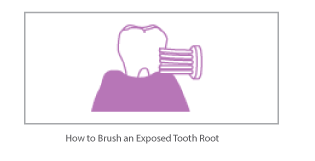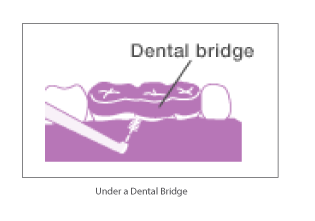Care by age group: Stage of Maturity

As we grow older, our gums become thinner and the tooth roots or areas under dental prostheses become susceptible to caries. In addition, the amount of saliva decreases and becomes pasty, which lowers its self-cleaning effect.
POINTS TO NOTE
- During this stage, caries and periodontal disease progress easily, which leads to increased tooth loss. It is important for those in this stage to practice careful tooth brushing using an interdental brush.
Dental and Oral Health and Care during the Stage of Maturity and Onward
Features of Teeth
Period of Tooth Loss
From about 40 years of age onward, it becomes easier for periodontal disease and caries to progress with age, and tooth loss also increases. Many people in this stage are in the prime of their working lives and it is difficult for them to regularly take the time to go and see a dentist. For this reason, by the time they notice issues, it tends to be too late. It is important for people in this stage to receive regular checkups at least once or twice a year.
In addition, the amount of saliva decreases due to causes such as medications, which can accelerate the progression of caries and periodontal disease. It is important for those in this stage to receive regular checkups at a dentist and preventive measures including scaling and teeth surface cleaning, in addition to tooth brushing and interdental brushing.
In addition, the amount of saliva decreases due to causes such as medications, which can accelerate the progression of caries and periodontal disease. It is important for those in this stage to receive regular checkups at a dentist and preventive measures including scaling and teeth surface cleaning, in addition to tooth brushing and interdental brushing.
Progression of Periodontal Disease (Gingivitis, Periodontitis)
From the stage of maturity onward, prevention of periodontal disease is particularly important. It is important for those in this stage to practice careful tooth brushing of the areas between the teeth and gums and interdental cleaning. In addition, smoking weakens the resistance of the gums, accelerating the progression of periodontal disease and slowing down healing. Cutting back on smoking is another important factor for the prevention and treatment of periodontal disease.
Period of Frequent Caries at the Tooth Roots
The progression of periodontal disease or improper tooth brushing methods cause the gums to sag and the tooth roots to be exposed. The surfaces of the tooth roots are softer than enamel and more susceptible to caries, so an effective method is to use fluoride toothpaste.
Reminders
Use an Interdental Brush in Combination with a Toothbrush
- If your gums are sagging and there are spaces between the teeth, it is important to remove plaque between teeth thoroughly using an interdental brush in combination with a toothbrush.
- Use an interdental brush for spaces under
prosthetic teeth(fake teeth).
- Exposed tooth roots are soft: brush lightly
so as not to cause damage.

Care for Dentures and Remaining Teeth
If a space is left open after extracting a tooth, the biting force will become weaker in accordance with
the amount of tooth extracted. Moreover, the teeth surrounding the extracted tooth will move and
cause the bite (occlusion) of the upper and lower teeth to become misaligned, which will increasingly
weaken the biting force. When you have a tooth extracted, have a denture placed in the open space.
It is recommended to remove a denture and carefully clean it and the remaining teeth after each meal.
In addition, be sure to consult with a dentist if your denture does not fit properly. Both full and partial
dentures should be removed before cleaning.
the amount of tooth extracted. Moreover, the teeth surrounding the extracted tooth will move and
cause the bite (occlusion) of the upper and lower teeth to become misaligned, which will increasingly
weaken the biting force. When you have a tooth extracted, have a denture placed in the open space.
It is recommended to remove a denture and carefully clean it and the remaining teeth after each meal.
In addition, be sure to consult with a dentist if your denture does not fit properly. Both full and partial
dentures should be removed before cleaning.
In the case of a partial denture, carefully brush the clasped area using an interdental brush. In addition,carefully brush the tooth on which the clasp is placed.Dentures can be cleaned effectively using denturecleansers or denture brushes.
Moreover, when brushing areas of extracted teeth, insert the toothbrush and place it properly onto the remaining teeth, and move the brush in small motions.






